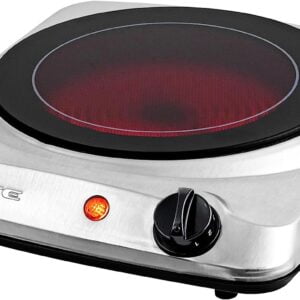Electric Stoves
Showing all 2 resultsSorted by popularity
-

Koblenz Victoria 4-Burner Gas Stove, Bronze, 16,000 BTUs, 18″ x 24
$64.90 -
Sale!

OVENTE Electric Single Infrared Burner, 7-Inch Ceramic Glass Hot Plate Cooktop with 5-Level Temperature Controls, Easy-to-Clean Stainless Steel Base, Compact Stove for Home, Dorm, and Office (Silver BGI101S)
Original price was: $34.99.$24.99Current price is: $24.99.
An Introduction To Electric Stoves
Electric stoves, also known as electric ranges or cooktops, are kitchen appliances that use electricity as their primary source of heat to cook food. They are widely used in households and commercial kitchens due to their ease of use, precise temperature control, and versatility. Electric stoves come in various styles, including freestanding ranges, slide-in ranges, and standalone cooktops.
Key Features and Components:
- Cooking Surface: Electric stoves have smooth, flat cooking surfaces made of either glass-ceramic or solid metal elements. These surfaces evenly distribute heat to cook food.
- Burners or Heating Elements: Electric stoves can have either coil-style burners or radiant heating elements embedded beneath the glass-ceramic surface. Coil burners are recognizable by their metal spiral coils, while radiant elements are flat and concealed beneath the glass.
- Control Panel: The control panel typically features knobs, touch controls, or digital displays, allowing you to adjust the cooking temperature and other settings.
- Oven: Most freestanding electric ranges come with an oven below the cooktop. The oven features heating elements for baking and roasting and can have various cooking modes, including bake, broiling, convection, and more.
- Indicator Lights: Electric stoves often have indicator lights that signal when the burners or oven are turned on or when they are still hot after use.
- Broiler Drawer: Some freestanding electric ranges have a broiler drawer at the bottom for easy broiling of meats and other dishes.
Advantages of Electric Stoves:
- Precise Temperature Control: Electric stoves offer precise temperature control, allowing for consistent cooking results.
- Ease of Cleaning: Smooth glass-ceramic surfaces make electric stoves easy to clean, as spills and splatters can be wiped away quickly.
- Safety Features: Many electric stoves come with safety features like child locks, which prevent accidental activation of the cooktop.
- Even Heating: Radiant heating elements provide even and steady heat distribution across the cooking surface.
- No Open Flame: Unlike gas stoves, electric stoves don’t have an open flame, reducing the risk of accidental fires.
Electric Stove Safety Tips:
- Avoid Overheating: Do not leave pots or pans unattended on the cooking surface to prevent overheating or boiling dry.
- Cooling Time: Allow the stove to cool down before cleaning the cooking surface or reaching into the oven to avoid burns.
- Proper Cookware: Use flat-bottomed cookware that matches the size of the heating element to ensure even cooking and prevent damage to the stove.
- Keep It Clean: Regularly clean the cooking surface and oven to prevent food buildup and maintain efficient performance.
- Electrical Safety: Check the power cord and outlet regularly for any signs of damage, and never use the stove if there are exposed wires.
Electric stoves are a popular choice for home cooks due to their ease of use, precise temperature control, and safety features. They offer a reliable and efficient way to cook a wide variety of dishes, from simple stovetop recipes to complex baked goods. When using an electric stove, always follow safety guidelines, maintain the appliance properly, and enjoy the convenience it brings to your cooking experience.


